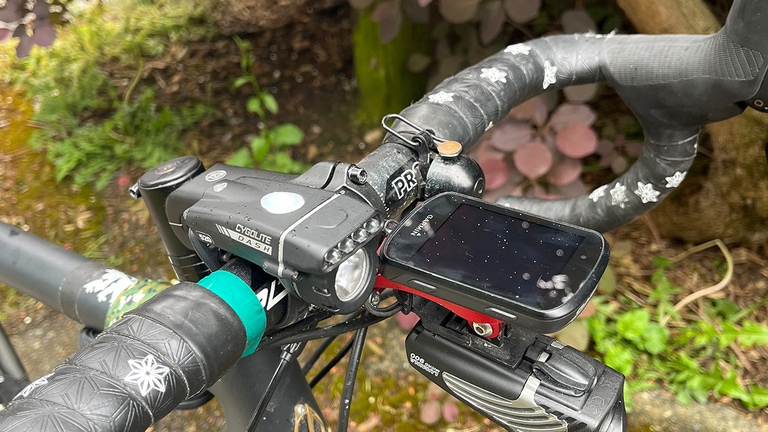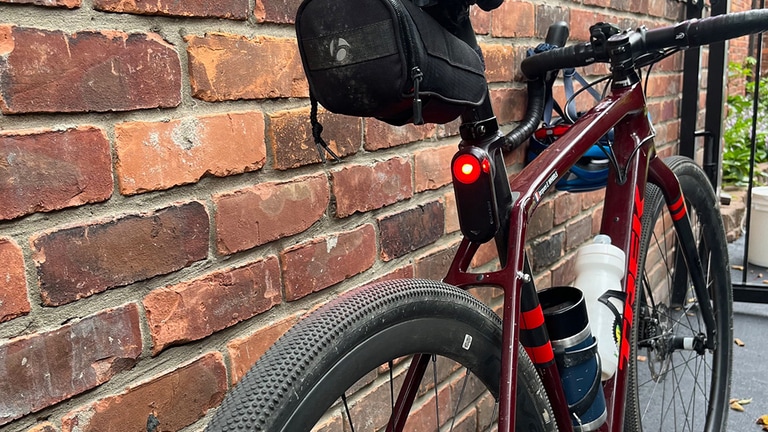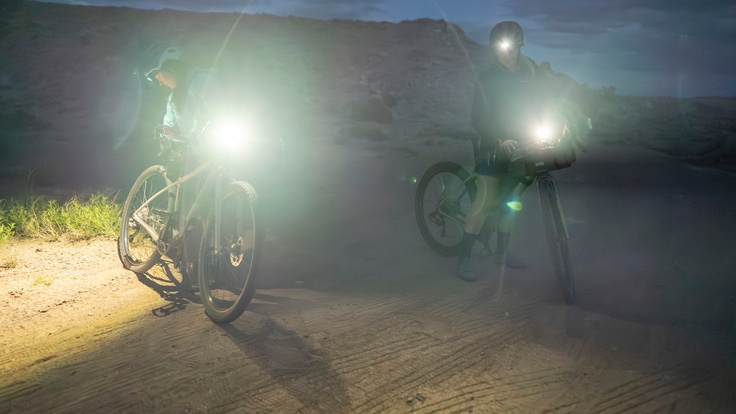Whether you’re a bike commuter heading to work in the wee hours or a mountain biker hitting singletrack after dark, a quality bike light can help you see better and stand out to vehicles. However, with so many options to choose from, finding the best bike light for your needs can be a challenging task (for optimal illumination, consider riding with a headlight and rear safety light; see more in our buying advice section). Here are our favorite front and rear bike lights available at REI. From models for mountain biking to rear-facing radar systems for road cyclists, we’ve got something for you.
Staff Picks
Find our quick recommendations here or read on for more in-depth breakdowns of our best bike lights.
- Best All-Around Front Bike Light: Cygolite Dash 520 Front Bike Light
- Best Bike Light for Riding Dark Streets: NiteRider Lumina Micro 900 Front Bike Light
- Best Bike Light for Mountain Biking: NiteRider Lumina 1800 Dual Beam Front Bike Light
- Best Bike Light Set: Lezyne Connect Smart 1000XL/KTV Smart Headlight and Taillight Set
- Best Rear Bike Light: NiteRider Vmax+ 150 Bike Taillight
- Best Rear Bike Light, Upgrade Pick: Garmin Varia RTL515 Rearview Radar Taillight
Best All-Around Front Bike Light
Cygolite Dash 520 Front Bike Light
Weight 2.8 ounces
Max brightness 520 lumens
Battery 1–10 hours (63 hours on flash mode)
Rechargeable Yes
Easy to use, reasonably priced and quick to charge, the Cygolite Dash 520 is one of the best all-around front bike lights we've used. Its standout features include a max output of 520 lumens, which is bright enough to light up dark city streets. Four daytime running lights help keep you visible to cars while using minimal battery power. “The daytime running lights are great and leave plenty of battery for the larger light for nighttime,” raved one rider who called it his "go-to" for in town riding. A single charge via USB powers the Dash 520 to last anywhere from one hour on high to 63 hours on flash mode. Our testers loved that it takes only three hours to charge and comes with a USB cable, making it a great option for commuters. It’s also lightweight (2.8 ounces) and up minimal space, whether on your handlebars or stored in a bag.
Memory settings also means you don’t need to rechoose your settings each time. And a simple and effective rubber strap lets you attach this light to a variety of handlebar diameters. "Easy to mount and use, as well as quick to remove for charging," one rider says. A REI customer sums it up: “For me, this is ideal: more for cars and other bikes to see me rather than powerful illumination. Lots of flashing functions that work consistently.” Buy here.

Best Bike Light for Riding Dark Streets
NiteRider Lumina Micro 900 Front Bike Light
Weight 4.6 ounces
Battery 2–11 hours (60 hours on walk mode)
Rechargeable Yes
With its focused beam pattern and 900 lumens of output, the NiteRider Lumina Micro 900 is an ideal companion for high-speed morning commutes or evening road rides with low-visibility. One of our riders used the Lumina Micro 900 for nighttime mountain biking and road biking on darker streets. (His pro tip: Get two. One for the bars, one for your helmet). The light features a quick-release mount that fits both standard and oversize handlebars that we found easy to mount and use. Its lightweight design (4.6 ounces) makes it a suitable option for mounting to a helmet. Its IP64 rating means it fully resists dust and is protected against splashing water—a plus for riding to work when it’s wet (and dark).
One customer wrote, “Dependable! Five great modes, simple to use, loooong battery life!” The battery lasts about two hours on high, 11 hours on low and 60 hours on walk mode. Other noteworthy features include an on/off button that’s easy to use—even while wearing gloves—and a lockout mode that helps prevent the NiteRider from turning on unexpectedly in a bag. We found the three light settings to be intuitive and easy to cycle through; the bright flash mode does a solid job of alerting motorists to your presence during the day. Buy here.
Best for Bike Light for Mountain Biking
NiteRider Lumina 1800 Dual Beam Front Bike Light
Weight 8.9 ounces
Max brightness 1800 lumens
Battery 1.5–10 hours (20 hours on walk mode)
Rechargeable Yes
A great mountain bike light should feature a beam pattern capable of covering the entire trail during after-hours rides. Additionally, the battery should last well beyond the length of your typical ride since you don’t want to get stuck out in the woods with nothing but your phone to light your way. And this light should also resist mud, rain and dust, and be easy to operate while wearing gloves. Enter the NiteRider Lumina 1800 Dual Beam, which checks all those boxes and more.
With 1,800 lumens on tap, the Lumina 1800 has plenty of power to reach far down the trail, and the lens emits a wide and even pattern that expertly lights up roots and rocks. "When you're about to descend that steep flowy trail at night, this is the one you want," says one of crew. "The Lumina lit up rocks, hits and other features on the trail." Other features include an on/off button that’s easy to use with gloved fingers, six light modes ranging from 300 to 1,800 lumens, and a lockout feature that helps prevent the light from turning on unexpectedly in a bag (just like on the Lumina Micro 900). Another one of our riders sums it up: It’s a “big bright light, has solid function, easy to mount and use, as well as quick to remove for charging.”
In terms of battery life, the Lumina 1800 is rated to last 1.5 hours on high, 10 hours on flashing and 20 hours on walk mode (the last is a great option for when you’re running low on battery and just need to make it back to your car). When it’s time for a recharge via the included USB cable, the sturdy mount is quick to remove. One tester concluded the NiteRider Lumina 1800 Dual Beam is “a great choice for higher speed mountain biking.” We agree. Buy here.
Best Bike Light Set
Lezyne Connect Smart 1000XL/KTV Smart Headlight and Taillight Set
Weight Headlight
Max brightness Headlight
Battery Headlight
Rechargeable Yes
Looking for a front and rear bike light set that works well across a wide range of cycling disciplines and pair seamlessly together? We think the Lezyne Connect Smart 1000XL/KTV Smart Headlight and Taillight Set is your best bet.
The standout feature of the Lezyne is that the front and rear lights pair wirelessly, meaning the front light controls the rear light. When you change a setting or switch the front light on or off, the rear light follows suit. No more reaching behind you as your ride or stopping and trying to adjust the rear light. As one Minneapolis-based rider put it, “It is very easy to click through the different modes, and I love that the modes automatically change together!” Another tester liked that the LED Ally app was intuitive to use: “One push of the headlight button changed both lights to pre-selected settings.”
In terms of performance, both front and rear lights excel for various types of riding. The headlight features a powerful output of 1,000 lumens; “the beam itself is excellent,” declared a Seattle cyclist who used it on many rides including road and mountain biking. The 75-lumen taillight provides 270 degrees of visibility. As for battery life, expect anywhere from 1.5 to 160 hours from the headlight and 10 to 19.5 hours from the taillight. One rider wished the mounting strap for the front light was a bit longer; he made it work for 35mm mountain bike bars but barely.
Finally, the set also features a water-resistance rating of IPX7, which means both lights protect against water immersion in water up to 1 meter for 30 minutes. Note: The set doesn’t come with an included charging cable. Buy here.
Best Rear Bike Light

NiteRider Vmax+ 150 Bike Taillight
Whether you’re heading out for an early weekend ride or commuting home from work, a rear bike light is important for visibility on the road. We think the NiteRider Vmax+ 150 is the best one for the job. There isn’t a single attribute that sets the NiteRider apart from the competition—it’s the entire package that makes it a smart choice for discerning riders. From its extremely bright light output with multiple flash modes to its overall ease of use, the NiteRider checks all the boxes for a quality rear bike light. Our Seattle rider proclaimed it “a great no-frills light that was easy to use.”
The NiteRider features both a quick-release seat post mount and a clip for a backpack or clothing, making it easy to attach to your setup. Plus, six different light modes (four flashing, two steady) offer options for different riders and preferences and a handy memory function, which defaults to the last setting you used. Its long, 25.5-hour runtime (on low) outlasts even long weekend rides.
For a complete lighting solution, NiteRider offers the Vmax+ 150 rear and top-rated Lumina Micro 900 front light in one convenient package. Buy here.
Best Rear Bike Light, Upgrade Pick
Garmin Varia RTL515 Rearview Radar Taillight
Weight 2.5 ounces
Max brightness 65 lumens
Battery 6–16 hours
Rechargeable Yes
The Garmin Varia RTLS515 is our pick for riders who are looking to significantly increase their awareness of vehicles approaching from behind. The standout feature of the Varia tailight is its rearview radar, which when paired with a compatible device (including Garmin watches, Garmin bike computers and some smartphones when paired with the Varia app), alerts you to cars coming up behind you. As our Michigan-based road cyclist put it, the radar “gives you aural and visual warnings of cars approaching from the rear. The light pattern also changes to alert vehicles as they are coming up behind the rider.”
You must own a compatible device to take full advantage of its radar function. For our Seattle rider, the Varia paired easily with his existing Garmin Edge 530 bike computer.
The light itself features four flash modes, which include solid (20 lumens), peloton (8 lumens), night flash (29 lumens) and day flash (65 lumens). You can expect anywhere from six hours of battery life on solid mode all the way up to 16 hours of battery light on day flash mode, which should meet most riders’ needs.
The setup and connection are “a little more involved than pressing the power button” says another of our Midwest-based road cyclists, “but it is relatively quick, easy and only needs to be done once.” One rider, though, found the mounting system a weak spot of the device; while Garmin provides different mounting adaptors to fit various stem shapes, the unit still swayed back and forth and would end up crooked during a ride.” Buy here.

Shop All Bike Lights
Bike Lights Buying Advice
When buying a new bike light, consider key factors such as brightness, lighting modes, battery life and the mounting system. Learn more about how to choose a light for you bike.
Types of bikes lights
High-output lights: If you're commuting or riding trails after dark, in low light conditions or bad weather, choose a high-output lighting system. Available in both front and rear lights, these offer maximum illumination and are typically rechargeable. While they tend to be more expensive, they help you see where you're going on the trail or road in many conditions. All the lights we tested fall into this category.
Safety bike lights: Front, side and rear safety bike lights, meanwhile, help others see you in dim light conditions. The brightest ones also improve your visibility in the daytime. But safety lights aren't bright enough to help you see where you're going for most night riding. When considering safety light models, you'll see differences in how they're mounted, the number of light-emitting diodes (LEDs) and whether they use disposable or rechargeable batteries.
For optimal illumination, choose both headlight and side and rear safety lights. Many bike lights are sold in sets like Lezyne Connect Smart 1000XL/KTV Smart Headlight and Taillight Set
Lumens and brightness
Counting lumens is important when you're shopping for a bike light. After all, lumens are the easiest way to measure the total quantity of light emitted by a light source. Higher lumens typically equal a brighter light. (You'll often find the lumen count in the light's name, or product specs.) If you're going to put a light through its paces on singletrack or frequently riding the roads at night, we generally recommend at least 1,000 lumens. For maximum brightness, the NiteRider Lumina 1800 Dual Beam Front Bike Light offers 1,800 lumens. Meanwhille, the Lezyne Connect Smart 1000XL hits the 1,000-lumen mark.
But while lumen output is important, it's equally important to be seen as it is to see. Most cyclists will encounter other motorists or riders during a night ride, so it's worth considering how visible you are from the back and sides.
Lighting modes
Most lights offer multiple settings that let you switch between flashing and steady modes, as well as low, medium or high brightness modes. A flashing light emits an eye-catching pulse (either steady or random) that uses less battery power than a steady beam. All six lights we tested switch from illumination mode to a daytime flashing pattern, which helps keep you safe and seen during the daylight hours. If you frequently encounter cross-traffic on your rides, look for a light that also has lateral visibility.
Battery life
A bright light is only as good as the battery powering it lasts, though, so the other critical thing to consider is battery life. Battery life depends on the light's battery type, the power of the system and the kind of LEDs in the light. Most bike lights, including our six picks, use rechargeable lithium ion batteries, which offer excellent power for their weight.
If you need brightness and battery life, you may need to consider a light that puts out fewer lumens but runs longer. Check the product specs for the stated battery life in the light's three settings: flashing, low and high.
Mounting systems
Headlights mount onto your handlebar or your helmet. One benefit of a helmet-mounted headlight is that you can redirect it by turning your head. Some mountain bike riders, and riders in poorly lit urban areas, choose to have both a handlebar light and a helmet light. For nighttime trail riding, you should consider using both types. So if you're riding twisty trails and using only one light, you'll find a helmet-mounted light to be the most versatile.
Rear safety lights, meanwhile, can often be mounted on a seatpost or rear rack, or attached to a pack, bike bag or pocket with clips. Side safety lights can be mounted on spokes or, if in a tube or string, around your frame to increase visibility from the side.
Another thing to consider is how the light affixes to your handlebars or helmet (and some do both). Check the specs on the mounting system to make sure it fits your handlebar or helmet. The best lights—including all of the lights featured here—attach firmly to your bars without damaging or scratching them, but are fairly easy to remove for charging.
Bike light law FAQ
Don't bikes come with lights? Federal law consumer safety standards require that all bikes intended for use on the road are sold with a combination of reflectors; generally, bicycles must have a colorless front reflector, reflectors on the back and front sides of the pedals and a red reflector on the rear. But bikes aren't required to be sold with lights beyond those reflectors. Still, it's a good idea to make sure you're able to see and be seen by others when cycling.
Is it illegal to ride at night or certain conditions without a light? Check the specific local and state laws. Many states require that bikes used in hours of darkness or during limited visibility conditions must have a white light that is visible from at least 500 feet.
Methodology
We polled our team of two-wheel-loving cyclists, including REI Co-op staffers and members, to crowdsource their favorite bike lights available at the co-op across a range of categories. We also pored over customer reviews and drew on our internal expertise to come up with a list of the best bike lights in this gear guide.






















